



Here's where we boldly confront the Bad News.
BAD NEWS ? Wha...?
Yup. grim reality!
Here's the bad news:
NOTHING IS PERFECT.
We do our best to maintain accuracy, but the real world produces imperfections.
- Our CAD systems assume a drill is perfectly centered in a round pad. It never is.
- We declare specific trace widths, and when we measure them on an actual board they are always slightly thinner or thicker.
- Multiple layers are perfectly aligned on our computer screens, but the fabricators can never quite manage to duplicate it. There will always be some misregistration.
- The board design is assumed to be flat, but boards in the final product can be bowed or warped.
- We designated some traces to be impedance controlled, but our measurements differ
I could go on and on and on, but I hope you see the point. As designers, we calculate exact numbers. We design with precision. Our CAD systems show us the ideal board.
In the real world, nothing is so precise. The final product will vary from the ideal in one way or another, hopefully in ways that are harmless.
How will you decide which defects are acceptable?
Measuring a group of supposedly identical products will show some amount of variability, so we need to define what range is acceptable for each type of measurement and at what point or limit we should reject the product as non-conforming. These ranges are called TOLERANCES.
Let's assume we are given a schematic for a design that will be mounted in a metal box, and the pre-defined box size is larger than the area we really need for the circuitry. This type of design allows us enough room to work comfortably, placing components away from the rectangular board edge. Our goal is to make sure the board fits inside the box and the board mounting hole pattern fits the box mounting hardware. In this situation, the dimensions of the board edge aren't as important, and we may be able to allow a large tolerance.
Now let's imagine that the same circuit has to fit on a standard-size expansion card for a personal computer, and will have a plated edge connector. In this scenario, even if there is plenty of board area on the card for the circuit, the board edge dimensions are more critical and the tolerance will have to be reduced to make sure the board fits properly. A smaller tolerance might still be within standard manufacturing process control, but it adds complexity, raises cost, and makes inspection more difficult.
Now let's consider a requirement to package the circuit into the confines of a cell phone enclosure. The new size constraints give us less board area to work with, and the dimensions are more critical. The designer must clearly define these expectations for the fabricator, and this design may limit the available manufacturing partners to those that are able to maintain these tighter tolerances repeatably.
With this example I was hoping to illustrate that the same circuit may have differing requirements based on the end-use application, and may have different tolerance ranges. But understand that the dimensional tolerance of the board outline is just one criteria among dozens. The board thickness may be important, or the plating thickness, hole diameters, layer registration, minimum annular ring, dielectric properties, panelization, etc. There are many parameters that contribute to a successful design, and some attention should be given to each of them as part of the process of designing a circuit board.
Now let's imagine that we have examined every way in which a circuit board parameter can vary, defined acceptable tolerances for each, and collected all of them into a specification document. When the next design comes along we may be able to use part or all of the previous specification, only changing the parameters that differ significantly. In this way, a company may have evolved a general board specification that applies to most if not all of its products, unless otherwise specified. This type of general specification is an effective tool for multiple designers working on similar designs or in large organizations like the military.
While proven specs remove risk and take some of the tedious and repetitive tasks out of the design process, a few problems quickly arise. In the early years of the electronics industry, a lot of effort was put into developing specs by large companies, and there was a natural desire to keep these documents private to maintain a competitive edge. Therefore, many of them were copyrighted and there was little open discussion or sharing of experience between organizations.
Looking at this situation from the board fabricator's point of view:
- multiple customers are providing different variations of every board parameter imaginable, making it difficult to establish consistent processes, and adding more test and inspection overhead to the entire industry.
- not every designer has a thorough understanding of the manufacturing process, and they sometimes OVER-specify tolerances without a scientific basis, adding unnecessary cost to the product.
What is really needed is a set of generic documents that can be used as a default for assigning acceptable tolerances, which can be over-ridden by designers when needed. That's what the organization called "IPC" has developed for us.
The IPC is an
"Association Connecting Electronics Industries"
Since 1957, IPC - Association Connecting Electronics Industries® has been guiding the electronic interconnection industry through its dramatic changes. A global trade association dedicated to the competitive excellence and financial success of its more than 2,700 member companies, IPC represents all facets of the industry, including design, printed circuit board manufacturing and electronics assembly. As a member-driven organization and leading source for industry standards, training, market research and public policy advocacy, IPC supports programs to meet the needs of an estimated $1.7 trillion global electronics industry.
Our Mission
IPC is a global trade association dedicated to furthering the competitive excellence and financial success of its members, who are participants in the electronics industry. In pursuit of these objectives, IPC will devote resources to management improvement and technology enhancement programs, the creation of relevant standards, protection of the environment, and pertinent government relations.
IPC encourages the active participation of all its members in these activities and commits to full cooperation with all related organizations.
That's how IPC describes itself, but you don't have to know any of that to be a circuit board designer. What you need to know is that the IPC maintains a series of publications on just about every aspect of the electronics industry, with new ones being introduced to keep up with technological advancement. These are developed by committees of volunteers from every sector of our industry. Some of the documents are joint publications with ANSI or JEDEC, two other world-wide standards organizations.
Here is a brief glance at some of the major players and their relationship to the electronics development process:
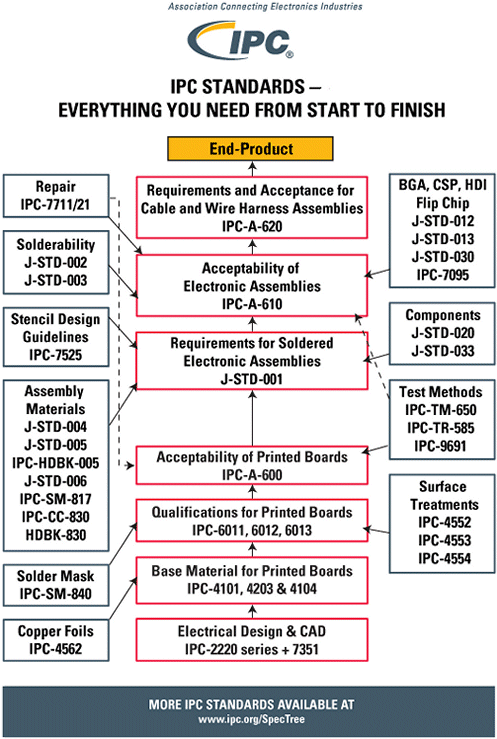
I'm happy to report that virtually all of the old U.S. military specifications ("Mil-Specs") have been declared obsolete in favor of the latest IPC specifications. More and more companies are adopting the IPC as a starting point, and we are all gradually reaching a consensus on how to communicate information between departments smoothly and reliably.

OK, Let's take a step back
and see where we stand....
Regardless of how much effort we put into trying to perfect a design, the actual product will have imperfections resulting from manufacturing tolerances. We need to know how to determine:
- what is preferred?
- what is acceptable?
- what should be resolved or rejected?
The set of guidelines and requirements can vary for different types of circuit boards depending on the type of product being designed. You can easily imagine that what might be acceptable for a circuit board in an inexpensive toy, might not be acceptable for electronics in a medical product. Three general end-product classes have been established to reflect differences in producibility, complexity, functional performance requirements, and verification (inspection/test) frequency.
- Class 1 - General Electronic Products, (limited life products suitable for applications whereave beenhe requirement is function of the completed product)
- Class 2 - Dedicated Service Equipment, (products where continued performance and extended life is required, and for which uninterrupted service is desired but not critical)
- Class 3 - High Reliability Electronic Products, (products where continued high performance or performance-on-demand is critical, product downtime cannot be tolerated, and the product must function when required)
The user is responsible for defining the product class. When sending a design out for bare board fabrication, the documentation should state the product class and any exceptions to specific parameters.
A good introduction to what an IPC specification is (and how the three classes of boards are used) can be seen at a glance in Appendix B of the document called IPC-6012 Qualification and Performance Specification for Rigid Printed Boards. Appendix B shows the performance requirements for rigid boards in an abbreviated list and in alphabetical order.
(If the text below is difficult to read,
click on the image to display a full-size PDF document)
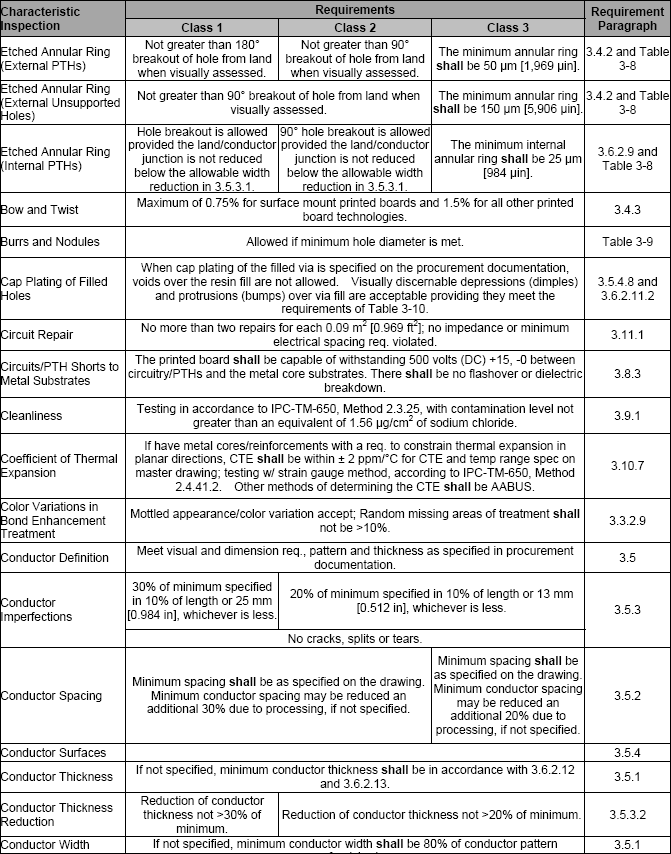
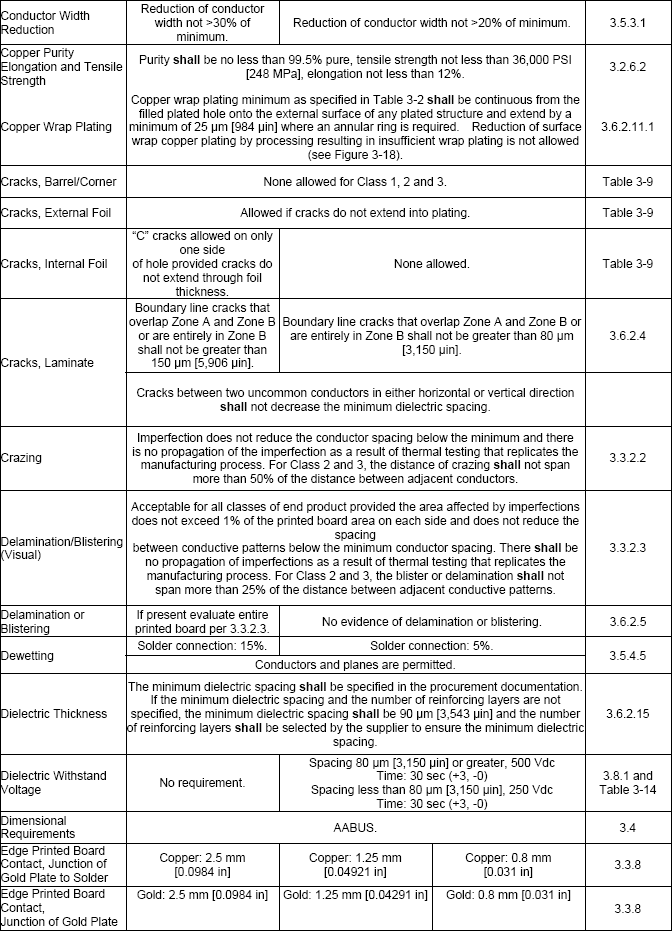
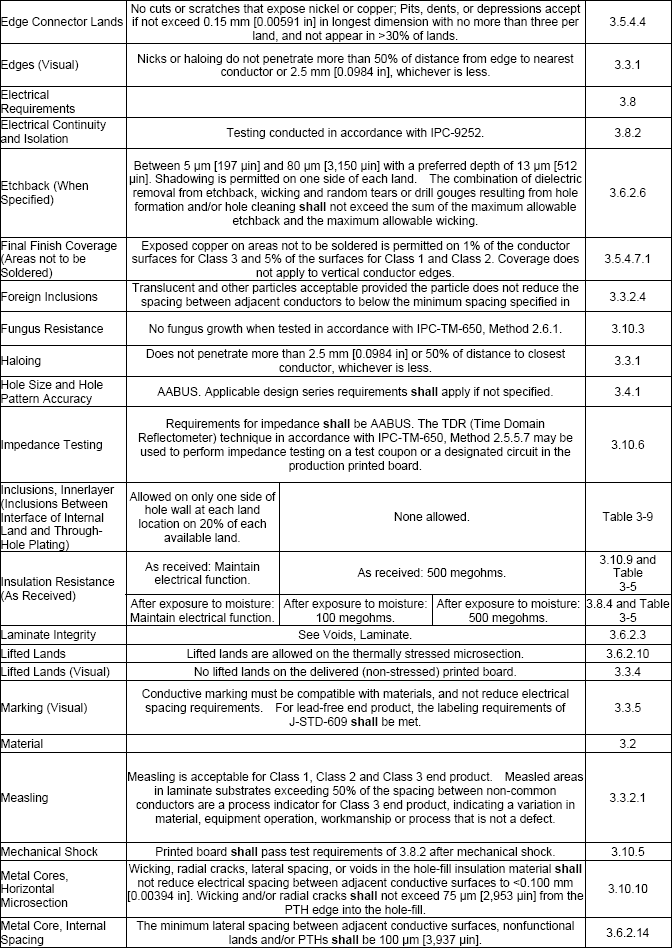
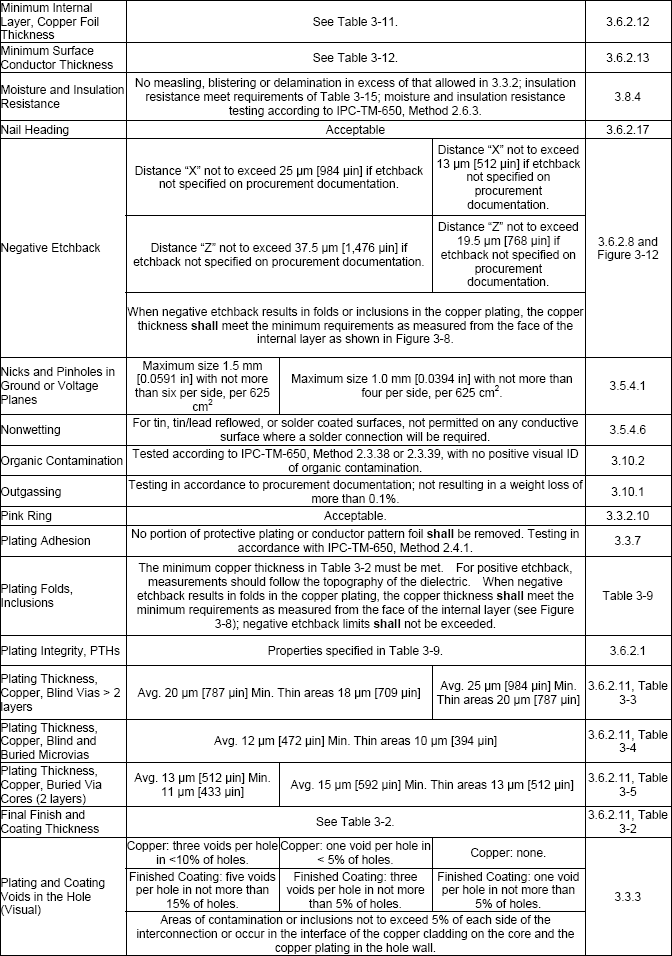
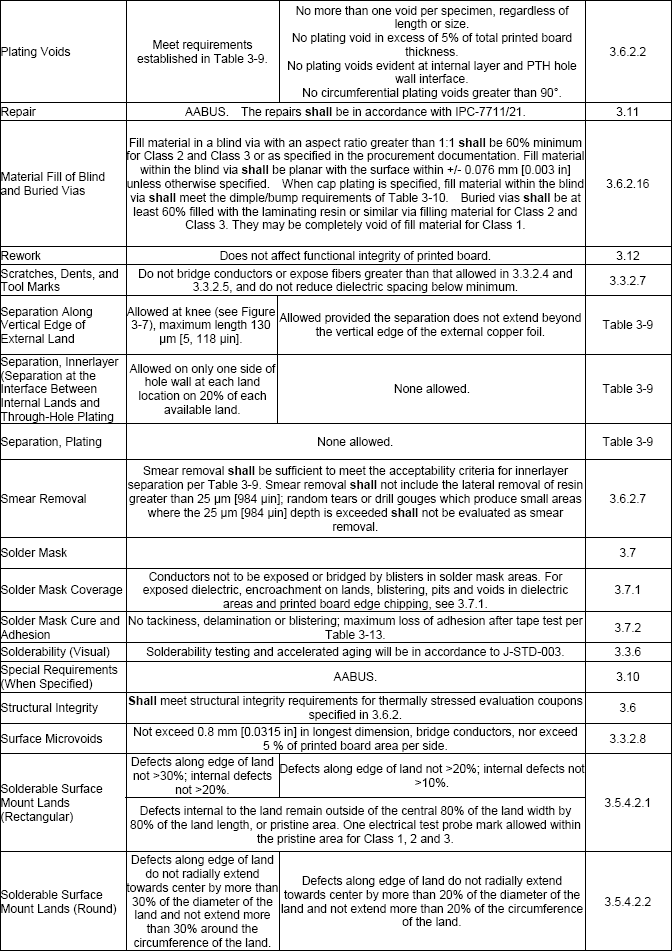
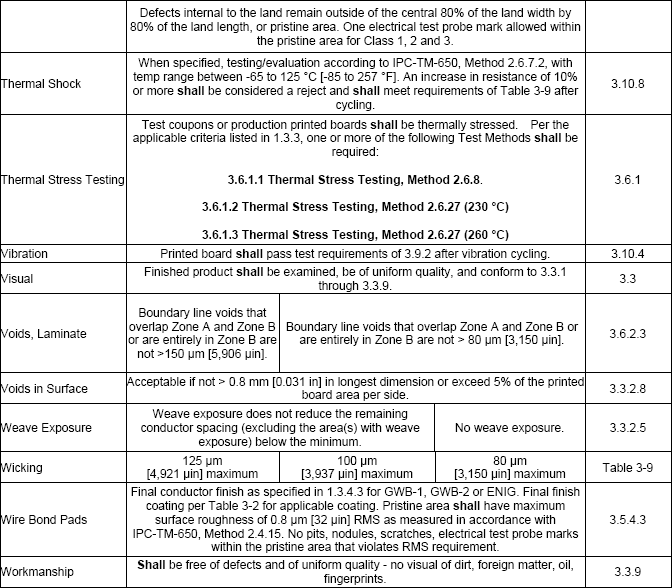
Pay attention to the fact that some conditions have different criteria for the three classes, but others apply the same criteria to all rigid boards regardless of class. The last column points to the associated section of the IPC-6012 document where lengthy descriptions, special conditions and tutorial information can be found.
IPC-6012 is available from the IPC at
http://www.IPC.org/6012
Keep in mind that this example took material from the rigid board specification, but there are many others. For example, similar specifications would be:
IPC-6013 Qualification and Performance for Flexible Printed Boards
IPC-6016 Qualification and Performance for High Density Interconnect (HDI)
IPC-6018 Qualification and Performance for High Frequency Boards
Many other publications have been developed for various subjects such as:
Design Guidelines, Board Storage and Handling, Manufacturer's Qualification, Material Declaration, Current Carrying Capabilty, Embedded Component Technology, Data Formats, Documentation, Adhesives, Laminate Material, Fabric and Foils, Plating, Via Protection, Marking Inks, Cleanliness, BTCs, Flip-Chip, BGAs, Through-Hole, Surface Mount Land Patterns, Stencils, Rework, Optical, Test, Quality and Reliability, SPC, Thermal, Acceptability, Inspection, Panelization, Dimensioning, Netlists, Hybrids, Drilling, Terms, Soldering, Marking, Shipping, Lead Free, and MORE...
There are a few IPC standards that I would consider essential for any circuit board designer. For the record, I don't receive any financial compensation for encouraging you to purchase them. Personally speaking, these documents have been invaluable to me:
IPC-2221 BUY Generic Standard on Printed Board Design
IPC-2222 BUY Sectional Design Standard for Rigid Organic Printed Boards
IPC-7351 BUY Requirements for Surface Mount Design and Land Pattern Standard
IPC-6011 BUY Generic Performance Specification for Printed Boards
IPC-6012 BUY Qualification and Performance Specification for Rigid Boards
If your responsibilities include resolving manufacturing defects, I would recommend two more:
IPC-A-600 BUY Acceptability of Printed Boards
IPC-A-610 BUY Acceptability of Electronic Assemblies
If your designs use specific technologies like BGAs, HDI, BTCs, etc, make sure to look for publications on those subjects
A full list of IPC documents can be found here:
ipc.org/4.0_Knowledge/4.1_Standards/revstat1.htm
NOTE: Specifications alone will not guarantee that your boards will be what you expected them to be. It is wise to do some type of periodic verification; which could be some combination of visual inspection, measurement, destructive analysis (or other test methods), and formal statements from suppliers such as "Certification of Compliance" documents. more about this subject can be found in the section on QUALITY
Summary
Standards give us a starting foundation for every aspect of product development related to circuit boards from design to final test, making the IPC truly an "Association Connecting Electronics Industries".
Published guidelines incorporate the valuable experience of engineers who came before us, their shared contributions giving us a consensus to build upon. Specifications give us a common tool to evaluate the results of our design decisions and manufacturing processes. Effective use of these tools will save resources, time, and money.
As technology advances we learn more, materials and processes improve, standards and guidelines evolve. You are encouraged to contribute to these revisions.
The IPC welcomes a wide variety of participation
Find Out How to Get Involved

!!! SPECIAL FEATURE !!!
For a "Blast From The Past", here's a free copy of the IPC's first publication (1958)
How to Design and Specify Printed Circuits

(Thanks to all committee volunteers who have helped develop standards)



HowToPCB
Page One
Comments
Schematics
Terminology
THE END
Customers
Data
Tolerance
BEGIN
Material
Thermal
Trace&Space
Design
Place
Route
Check
CADtoCAM
QUALITY
HELP
Question
Organize
Who Me?